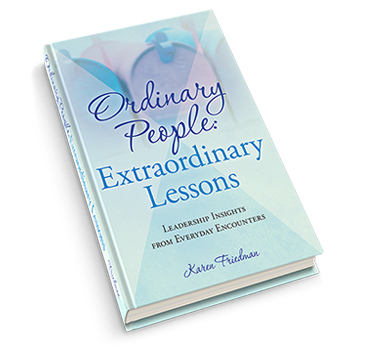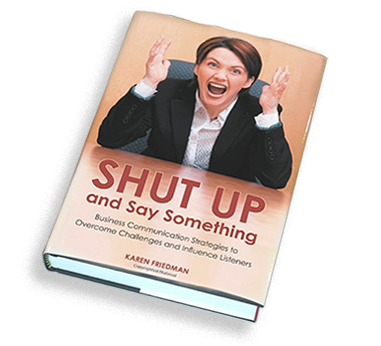I have spent many years in communications. Beginning with a career as journalist, followed by more than two decades heading my own leadership communications firm, I have coached thousands of people on four continents. I am not telling you this to brag, but rather because I found myself in a unique situation when preparing for a recent speaking engagement.
A client hired our firm to deliver a main stage session at a conference to teach attendees how to improve their presentation and communication skills. It is part of what we are known for and what we do in a variety of formats every day.
The client asked if we would send our slides in advance. Normally, we prefer not to as our slides are often very visual and don’t make a lot of sense without the speaker providing context. In this case, the production company running the meeting wanted everyone’s slides loaded into the same computer, so we complied.
To our surprise, two of our slides were questioned. The first slide emphasized the importance of using visuals. We explain how visuals help audiences better engage and understand information in a greater way than text because visuals help people retain information emotionally connect with a subject.
The other slide conveyed what I have dubbed the three E’s of effective communication: Engaging, Efficient and Easy to Understand.
One of the conference organizers asked that we provide sources for that information. I said that I was the source. He said without citing a book or research, I couldn’t use that information. I explained this is something I first learned as a television news reporter and have continued to observe helping people prepare and deliver presentations. I further explained that I have authored several books on effective business communication so I could cite my own books.
As for the three E’s, I told him I often create acronyms to help people retain information and the three E’s is an example of that. I further clarified that learning how to better engage, organize information efficiently and use visuals and examples to help make information easy to understand can help people become more effective communicators. Again, he wanted a reference even though I was the reference. In order to use the information, I created, I actually had to cite other sources who say the same thing I say.
It struck me as odd and insulting that this organization would hire a communications expert to speak at their meeting and then question the expertise of that expert. There are many definitions of what qualifies someone to be an expert.
Citing Forbes, an expert is someone having comprehensive or authoritative knowledge in a particular area. According to Webster, you need to be more than skilled, accomplished, talented, proficient, or gifted to be an expert. I believe while some people who have multiple degrees and diplomas label themselves as experts in their field, other experts are often people who have done something for a long time. For example, if you have a favorite hairdresser who styles your hair, that person may not be as schooled as someone at another salon, but because you value their knowhow you consider them expert at what they do.
Years ago, we competed for a media training contract at a well-known company. When interviewed by the Human Resources manager, she kept asking if our coaches had certifications in media training. I explained that all of our media trainers were former award-winning journalists who had covered thousands of stories and understood how reporters think, what they would ask and how information may be used in a story. Additionally, I shared our media training experience and references.
She said even though we had great credentials, she couldn’t hire us because we weren’t certified in conducting media training workshops. I looked up how someone becomes certified in media training and discovered people providing this so-called certification were other media trainers like us. For a sizeable fee, they were teaching people with no media background how to conduct media training sessions and providing certificates of completion. This HR manager valued that piece of paper more than firsthand expertise.
If different people have different ideas of what qualifies someone as an expert, how can you tell who is really an expert and who is not? Here are my top five traits to look for:
- Years of Experience
Anyone can read articles, watch videos or take a course. People who have years of real-world experience can help others understand what works, what doesn’t and use that experience to help you minimize mistakes.
- Testimonials and Referrals
If you have helped people achieve positive results, they are happy to talk about their success and refer you to others.
- Focus on you
Real experts focus on you, not on themselves. They want to share their knowledge and expertise to help you become more knowledgeable and proficient at what you do.
- Toss out the script
Real experts don’t need scripts to highlight their expertise. They have enough knowledge and subject understanding to pivot when interrupted or thrown a tough question. They share examples and anecdotes that can only come from experience.
- Give it away
Real experts aren’t worried that you’ll repeat their words or use their techniques. They have reached a point in their careers where they are supremely confident in their wisdom and style.
A true expert also knows that people value more than just their knowledge. They value how that expert shares that knowledge and provides a safe environment to help them see things differently when working together.








Leave a Reply
You must be logged in to post a comment.